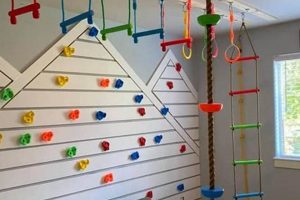Creating a personalized display of photographs or artwork on a wall using self-initiated projects is a popular approach to home decor. These visual arrangements can range from simple grids to complex, free-form compositions. The essence lies in the individualized selection and arrangement of imagery to reflect personal style and memories.
The implementation of such displays offers several advantages. It provides an opportunity to showcase valued photographs, artwork, and mementos, transforming a blank wall into a focal point and conversation starter. The flexibility of these projects allows for adaptation to changing tastes and evolving collections, providing a dynamic element within the living space. Historically, the practice reflects a long tradition of personalizing domestic environments, adapting to various aesthetic movements and technological advancements in photography and printing.
This discussion will explore various approaches to planning and executing such projects, encompassing considerations of layout, framing options, mounting techniques, and aesthetic styles to inspire diverse and visually appealing wall displays.
Guidance for Executing Personalized Wall Displays
The following guidance offers actionable insights for planning and realizing a visually compelling and personalized display of images on a wall.
Tip 1: Plan the Layout. Before affixing anything to the wall, create a scaled representation of the space and the proposed arrangement. Utilize paper cutouts corresponding to frame sizes to experiment with different configurations on the floor or a table. This step mitigates errors and ensures a balanced composition.
Tip 2: Maintain Consistent Spacing. Aim for uniform intervals between frames, typically ranging from two to four inches. Consistency enhances visual harmony and avoids a cluttered appearance. Use a measuring tape and level to ensure accuracy during installation.
Tip 3: Consider a Unified Color Palette. Employ frames with similar finishes or colors to create visual cohesion. While variety can be incorporated, a dominant color theme helps to integrate disparate images into a unified display. Neutral tones, such as black, white, or natural wood, often provide a versatile backdrop.
Tip 4: Vary Image Sizes and Orientations. Incorporate photographs and artwork of differing dimensions and orientations to add visual interest. A balanced arrangement might include a larger focal piece surrounded by smaller, supporting images. Rotate orientations to break up monotony.
Tip 5: Use a Level. Achieving even alignment is essential to a professional appearance. Use a level when hanging each frame to prevent tilting. Recheck alignment periodically during installation.
Tip 6: Employ Appropriate Mounting Hardware. Select mounting hardware suited to the wall type and the weight of the frames. Lightweight frames can be secured with adhesive strips, while heavier frames necessitate hooks and nails or screws anchored into studs. Consult a hardware professional if unsure.
Tip 7: Document the Process. Photograph the final arrangement for future reference. This record facilitates replication in another location or re-creation after modifications.
Careful planning, precise execution, and attention to detail are crucial to achieving a successful and aesthetically pleasing individualized display. By adhering to these guidelines, one can transform a blank wall into a personalized gallery.
Next, we explore specific styles and creative approaches applicable to personalized image arrangements.
1. Layout
Layout, in the context of do-it-yourself picture wall creation, represents the fundamental organizational structure dictating the placement of individual elements within the designated space. The chosen arrangement significantly influences the overall aesthetic impact and the narrative conveyed. A poorly conceived layout can result in a visually chaotic or unbalanced presentation, undermining the intended effect of showcasing photographs and artwork. Conversely, a well-planned layout enhances visual appeal, draws the viewer’s eye strategically, and effectively communicates a sense of order and purpose. A symmetrical grid, for instance, offers a formal and structured appearance, whereas an asymmetrical or free-form arrangement lends a more casual and dynamic feel. The selection of layout, therefore, directly affects the perceived value and impact of the finished display.
Real-world examples abound to illustrate this connection. Consider a series of family photographs displayed in chronological order, gradually ascending a staircase. This layout not only decorates the space but also narrates a family history, imbuing the wall with personal significance. Alternatively, a collection of landscape prints arranged salon-style, with frames overlapping and varying in size, creates a visually rich and immersive experience. In both instances, the layout is not merely a decorative element but an integral component of the overall composition, shaping the viewer’s perception and emotional response. Neglecting to plan this element can result in a disjointed collection of images lacking coherence and visual appeal. Moreover, layout consideration is paramount to determining the ideal image sizes and frame proportions needed to achieve the desired effect, often necessitating careful pre-planning and measurement before commencing the physical installation process.
In summation, the relationship between layout and successful creation of a personalized wall display is inseparable. An intentional layout contributes significantly to visual harmony, enhances storytelling capabilities, and maximizes the aesthetic impact of the displayed images. Understanding and prioritizing this crucial element is essential to transforming a blank wall into a compelling and personalized statement. Potential challenges include adapting pre-existing image collections to a cohesive layout or creatively incorporating irregularly shaped spaces, but careful planning and experimentation can overcome these hurdles to achieve the desired result.
2. Framing
Framing serves as a critical component in the successful execution of personalized photographic arrangements. The selection of frames significantly influences the overall aesthetic impact of the display, either enhancing or detracting from the individual images and the composition as a whole. In the context of do-it-yourself projects, framing options are especially pertinent, offering a vast array of styles, materials, and finishes to suit diverse tastes and interior design schemes. A poorly chosen frame can overpower an image, clash with the surrounding decor, or diminish the perceived value of the artwork. Conversely, a well-selected frame complements the image, provides visual context, and elevates the overall presentation. Therefore, understanding the relationship between framing and the success of personalized displays is essential for achieving a visually compelling result.
Consider, for example, a collection of black and white photographs. Simple, minimalist black frames often provide an ideal complement, allowing the images to remain the focal point while providing a clean, modern aesthetic. Alternatively, a collection of vintage botanical prints might benefit from ornate, gilded frames that enhance their historical character and add a touch of elegance. The choice of matting also plays a crucial role. A wide, neutral mat can create a sense of spaciousness and draw attention to the image, while a colored mat can coordinate with the surrounding decor. In practical application, careful consideration of frame style, material, color, and matting is crucial to creating a cohesive and visually appealing display. Furthermore, DIY projects offer opportunities to personalize frames through painting, staining, or embellishing, adding a unique touch that reflects personal style.
In summary, framing is not merely a functional element in the creation of individualized image arrangements; it is an integral design consideration that significantly affects the visual impact and emotional resonance of the display. The careful selection of frames, matting, and personalization techniques can transform a collection of photographs and artwork into a curated gallery reflecting individual taste and style. The challenges inherent in this process include navigating the vast array of available options and ensuring that the selected frames complement both the images and the surrounding environment. Successfully addressing these challenges results in a harmonious and visually compelling display that enhances the aesthetic appeal of the space and celebrates personal memories and artistic expression.
3. Spacing
In the context of personalized photographic displays, spacing refers to the measured distance between individual frames or objects within the arrangement. This element significantly impacts the visual coherence and aesthetic quality of the overall presentation. Inadequate spacing can lead to a cluttered and visually overwhelming effect, while excessive spacing can create a sense of disconnect and fragmentation. The effective management of spacing, therefore, is a critical determinant of success in creating visually pleasing and impactful individualized arrangements.
Consider, for example, a grid arrangement of identical frames. Consistent spacing between each frame, typically ranging from two to four inches, establishes a sense of order and visual rhythm. This uniformity allows the eye to move smoothly across the display, appreciating each image individually while recognizing their collective harmony. Conversely, inconsistent spacing in the same arrangement introduces visual tension and diminishes the perceived professionalism of the project. In free-form arrangements, spacing becomes even more crucial. The distance between elements must be carefully considered to create a balanced composition that avoids feeling either too crowded or too sparse. Negative space, deliberately employed, can draw attention to specific images or create visual interest. Practical application involves meticulous measurement and planning, often utilizing templates or mock-ups to visualize the final result before installation.
In conclusion, the management of spacing is not merely a technical detail but an integral design consideration that significantly affects the visual impact of personalized displays. Achieving consistent and visually balanced spacing requires careful planning, precise measurement, and an understanding of the principles of visual composition. Addressing the challenge of maintaining consistent spacing in irregularly shaped spaces or when incorporating frames of varying sizes necessitates creative problem-solving and a commitment to meticulous execution. By prioritizing and mastering this element, one can create visually compelling and aesthetically pleasing arrangements that enhance the appeal of the space and celebrate individual memories and artistic expression.
4. Mounting
Mounting, in the context of do-it-yourself personalized photographic wall displays, constitutes the method of securing individual frames or elements to the wall surface. The chosen mounting technique directly impacts the stability, longevity, and aesthetic presentation of the overall arrangement. The selection of inappropriate mounting hardware or techniques can result in structural failure, damage to the wall surface, or a visually unappealing finish. Consequently, a thorough understanding of available mounting options and their suitability for specific wall types and frame weights is essential for successful implementation of such projects. Improper mounting invalidates the aesthetic intent of the display.
Consider, for example, the implementation of a gallery wall comprising multiple frames of varying sizes and weights on a plaster wall. Utilizing solely adhesive strips for all frames, without consideration for weight limitations, will likely lead to the detachment of heavier frames, potentially damaging both the frames and the wall. A more appropriate approach would involve a combination of techniques: adhesive strips for lightweight frames, and picture hooks or nails anchored into wall studs for heavier frames. Another example involves utilizing wire hanging systems, which require fewer holes in the wall and allow for easy adjustments to the arrangement. However, the stability of the wire system is dependent on the proper installation of the supporting hardware and the weight capacity of the wire itself.
In summary, mounting represents a critical and often overlooked aspect of creating a successful individualized photographic wall display. The selection of appropriate mounting techniques and hardware is directly linked to the stability, longevity, and aesthetic presentation of the arrangement. Neglecting to address this element can result in structural failure and diminished visual appeal. Challenges include matching mounting techniques to specific wall types and frame weights, as well as concealing mounting hardware for a seamless finish. Prioritizing careful planning and informed decision-making in this area is essential for transforming a blank wall into a visually compelling and enduring personalized gallery.
5. Color Palette
The selection of a color palette is intrinsically linked to the success of do-it-yourself personalized photographic displays. The colors present within the images, the frames, and the surrounding environment exert a substantial influence on the overall visual impact and perceived aesthetic quality of the arrangement. A thoughtfully curated color palette fosters visual harmony and reinforces the desired mood or atmosphere, while a discordant or haphazard color scheme can lead to visual distraction and diminish the impact of the individual images. Consequently, careful consideration of color is paramount to achieving a cohesive and visually compelling personalized display.
The impact of color palette choice is readily apparent in diverse scenarios. For instance, a collection of sepia-toned historical photographs might be enhanced by using frames in warm, earthy tones, creating a vintage aesthetic. Conversely, a gallery wall featuring vibrant contemporary artwork could benefit from frames in neutral shades, allowing the artwork to take precedence without competition. The color of the surrounding wall also plays a crucial role. A brightly colored wall can serve as a bold backdrop, enhancing the vibrancy of the displayed images, while a neutral-toned wall provides a versatile canvas that allows for greater flexibility in frame and image selection. Practical application often involves creating a mood board or digital mockup to visualize the interplay of colors before commencing the physical installation process. Color choices should be selected to complement the existing decor while also reflecting the personal style of the individual creating the display.
In summary, a considered color palette serves as a unifying element within a personalized photographic display, enhancing visual harmony and contributing to the overall aesthetic impact. The challenges inherent in selecting and implementing an effective color palette include navigating the vast array of available options and ensuring that the chosen colors complement both the images and the surrounding environment. Prioritizing color as a core design consideration is essential for transforming a blank wall into a cohesive, visually engaging, and personalized gallery that reflects individual taste and artistic expression.
6. Image Variety
Image variety represents a crucial element in the design and execution of personalized photographic displays. The deliberate incorporation of diverse image types, sizes, and styles significantly enhances the visual interest and narrative complexity of the overall arrangement. A lack of variety can result in a monotonous and unengaging display, diminishing the potential impact of the selected photographs and artwork.
- Content Diversity
Content diversity pertains to the range of subjects and themes depicted within the images. Incorporating landscapes, portraits, candid snapshots, abstract art, and text-based elements creates a richer visual tapestry. For example, a display might combine formal family portraits with informal travel photos, adding depth and personality to the arrangement. The absence of content diversity limits the storytelling potential of the display.
- Format and Size Variation
Format and size variation involves the inclusion of images in different shapes and dimensions. Mixing small, intimate snapshots with larger, statement pieces introduces visual hierarchy and prevents monotony. For instance, a series of small square prints can be juxtaposed with a large panoramic photograph, creating a dynamic and visually engaging composition. Uniformity in format and size reduces visual interest.
- Style and Treatment Contrasts
Style and treatment contrasts refer to the incorporation of images with differing aesthetic qualities. Combining black and white photographs with color prints, or mixing traditional photography with digital art, adds visual complexity and sophistication. A display might incorporate vintage photographs with modern digital prints, showcasing a timeline of photographic techniques and styles. Homogeneity in style limits the creative potential of the display.
- Framing and Presentation Differences
Framing and presentation differences involve employing a range of frame styles, matting options, and mounting techniques. Mixing framed images with unframed prints, or using frames of varying materials and colors, adds visual texture and depth. A display might combine sleek, modern frames with rustic, vintage frames, creating a unique and eclectic look. Uniformity in framing reduces the aesthetic impact.
The strategic implementation of image variety elevates personalized photographic displays from simple collections to visually compelling narratives. By embracing diverse content, formats, styles, and framing techniques, one can create an arrangement that captures attention, conveys personal meaning, and enhances the aesthetic appeal of the space. The absence of image variety limits the potential for storytelling and visual engagement, resulting in a less impactful and memorable display.
7. Storytelling
The effectiveness of personalized photographic displays hinges significantly on their capacity to convey a narrative. Storytelling, in this context, transcends mere aesthetic arrangement; it becomes the purposeful curation of images to communicate experiences, memories, or themes that resonate with the creator and engage the viewer. Without a narrative thread, the display risks becoming a disjointed collection of images, lacking emotional depth and failing to leave a lasting impression. The cause and effect relationship is clear: a deliberate focus on storytelling elevates a simple display into a personalized visual biography or artistic statement. The absence of this focus reduces the display to mere decoration.
The importance of storytelling manifests in several practical applications. For example, a display commemorating a family’s history might feature photographs spanning generations, arranged chronologically to narrate the family’s evolution and achievements. Each image serves as a chapter in a visual novel, contributing to the overall narrative arc. Another example could involve a collection of travel photographs, organized not by location but by a common theme, such as human connection or environmental change. These choices transform the wall into a commentary on the world, reflecting the individual’s values and perspectives. Storytelling is further enhanced through the incorporation of captions, quotes, or memorabilia that provide context and reinforce the intended message.
The challenges inherent in implementing storytelling within personalized displays include selecting images that collectively contribute to a cohesive narrative, avoiding visual clichs, and maintaining a balance between personal expression and universal appeal. Despite these challenges, understanding the intrinsic connection between storytelling and personalized displays remains paramount. By prioritizing narrative intent, creators can transform a blank wall into a powerful medium for self-expression, cultural commentary, and the preservation of cherished memories.
Frequently Asked Questions Regarding Personalized Photographic Wall Displays
The following addresses common inquiries and misconceptions surrounding the creation and implementation of individualized photographic wall displays.
Question 1: Is professional assistance required to create a visually appealing photographic arrangement?
Professional assistance is not mandatory. Careful planning, attention to detail, and adherence to fundamental design principles can yield successful results. Resources such as online tutorials, design guides, and pre-designed templates can aid in the process.
Question 2: What is the optimal spacing between frames in a gallery wall?
Optimal spacing varies depending on the scale of the arrangement and the size of the frames. A general guideline is to maintain consistent spacing between two and four inches. Experimentation may be necessary to achieve a visually balanced effect.
Question 3: Is it necessary to use matching frames for all images in a photographic display?
Matching frames are not obligatory. A unified aesthetic can be achieved through consistent color palettes, materials, or styles. Mixing frame types can introduce visual interest but requires careful consideration to avoid a disjointed appearance.
Question 4: What is the best way to protect images from fading when displayed on a wall?
Protect images from prolonged exposure to direct sunlight and ultraviolet radiation. Utilize UV-protective glass or acrylic for framing. Archival-quality prints and acid-free matting are recommended to preserve image integrity over time.
Question 5: What are the most appropriate mounting techniques for various wall types?
Mounting techniques depend on wall construction and frame weight. Adhesive strips are suitable for lightweight frames on smooth surfaces. Heavier frames necessitate hooks or nails anchored into wall studs. Plaster walls may require specialized anchors. Consult a hardware professional for guidance when uncertain.
Question 6: How can a cohesive theme be established in a photographic display featuring diverse images?
A cohesive theme can be established through consistent color palettes, subject matter, framing styles, or narrative threads. Identify a unifying element that connects the disparate images and reinforces the overall message of the display.
Careful planning, informed decision-making, and attention to detail are essential to achieving a successful and visually appealing personalized photographic wall display. The provided answers serve as a starting point for navigating the various considerations involved in this process.
The following section will provide actionable tips and techniques for ensuring longevity and preservation of the finished personalized visual displays.
diy picture wall ideas
This discussion has explored the multifaceted nature of individualized photographic displays, elucidating key considerations for planning, executing, and preserving these personal expressions. Crucial elements, including layout, framing, spacing, mounting techniques, color palette, image variety, and storytelling potential, have been examined in detail. Furthermore, common misconceptions and frequently asked questions have been addressed to provide practical guidance for successful implementation.
The creation of personalized image arrangements represents a potent means of self-expression and environmental enhancement. Continued innovation in materials, techniques, and design principles promises to further refine the art of do-it-yourself photographic display, affording individuals ever-greater opportunities to craft visually compelling and deeply personal spaces. Careful consideration of the principles outlined herein will contribute to enduring and impactful results.






![Build a DIY Wheeled Patio Privacy Wall Screen [Easy!] The DIY Hub: Creative Crafts, Repairs & Life Hacks Build a DIY Wheeled Patio Privacy Wall Screen [Easy!] | The DIY Hub: Creative Crafts, Repairs & Life Hacks](https://craftingdiycenter.com/wp-content/uploads/2025/07/th-2201-300x200.jpg)
